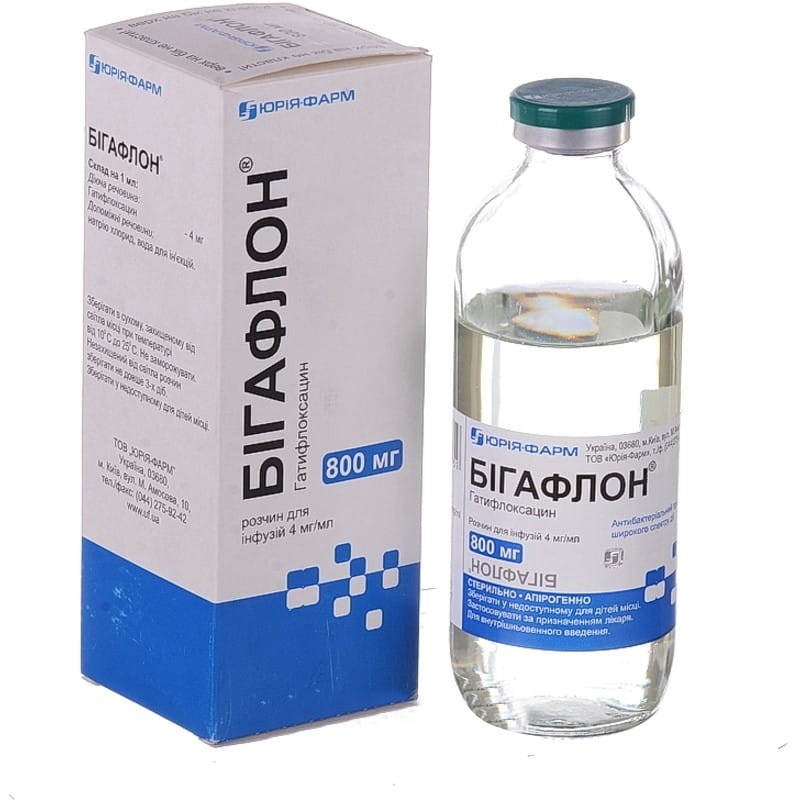



 Secure and encrypted payment processing
Secure and encrypted payment processing We ship to over 40 countries including the USA, UK, Europe, Australia and Japan
We ship to over 40 countries including the USA, UK, Europe, Australia and Japan Guaranteed refund or reship if you haven't received your order
Guaranteed refund or reship if you haven't received your orderBigaflon is an antimicrobial agent of the fluoroquinolone group with a wide spectrum of antibacterial action. highly active against gram-negative and gram-positive bacteria, as well as intracellular microorganisms. E. coli, salmonella spp., shigella spp., klebsiella spp., proteus spp., pseudomonas spp., enterobacter spp., serratia spp., citrobaсter spp., hafnia spp., yersinia spp., staphylococcus are sensitive to the drug , streptococcos spp., neisseria spp., haemophilus influenzae, brucella spp., vibrio spp., providencia spp., chlamydia spp., campylobaсter spp., aeromonas spp., plesiomonas spp. gatifloxacin is also effective against bacteria producing β-lactamases, including non-fermenting bacteria, pathogens of nosocomial infection, as well as atypical microorganisms such as chlamydia pneumoniae, chlamydia trahomatis, m. pneumoniae, l. pneumophila, ureaplasma. in addition, pathogens such as mycobacteria are sensitive to gatifloxacin, h. pylori, anaerobes.
Treponema pallidum is not sensitive to Bigaflon.
The mechanism of the bactericidal action of Bigaflon is associated with the inhibition of the bacterial enzyme DNA gyrase and type IV topoisomerase, which blocks cell division and leads to the death of bacteria. Bigaflon penetrates well into tissues and body fluids, creating high concentrations in saliva, sputum, lungs, bile, gall bladder, prostate gland, urine, skin, and bone tissue. The pharmacokinetics of gatifloxacin is linear in the dose range of 200-800 mg, which is used for 14 days. The equilibrium state is reached on the 3rd day of taking the drug. The average values of Cmax and the minimum concentration in plasma in equilibrium when using the drug 400 mg 1 time per day are 4.6 and 0.4 g / ml, respectively.
About 20% of the drug binds to plasma proteins. Cmax Bigaflon in blood plasma (after iv infusion of 200 mg for 30 minutes) is achieved immediately. T½ the drug is 7-14 hours and does not depend on the dose. Over 70% of the drug is excreted in the urine for 48 hours. Less than 1% is excreted in the urine as an ethylenediamine and methylenediamine metabolite, 5% is excreted in the feces. Renal clearance, regardless of the dose, is 124–161 ml / min.
Bigaflon for infusion is indicated for infectious and inflammatory diseases caused by microorganisms sensitive to it: respiratory tract, ear, nose and throat infections, skin and soft tissues, abdominal organs, kidneys, urinary tract infections, gynecological infections, osteomyelitis, septicemia, gonorrhea, tuberculosis, dysentery, salmonellosis. the drug is used for preoperative prophylaxis and postoperative treatment of surgical infections in patients with reduced immune status.
Bigaflon is administered at a dose of 400 mg once a day with creatinine clearance ≥40 ml / min. in chronic bronchitis in the exacerbation phase, 400 mg (100 ml) of the drug is administered 1 time per day for 7-10 days. in acute sinusitis - 400 mg 1 time per day for 10 days. with community-acquired pneumonia - 400 mg 1-2 times a day for 7-14 days. for uncomplicated urinary tract infections, 400 mg is administered once or 200 mg for 3 days, and for complicated ones, 400 mg once a day for 7-10 days. 200 mg for 5-7 days are prescribed for the treatment of infections of the skin and soft tissues. for the treatment of tuberculosis, depending on the form and severity of the course of the disease, 800 mg is prescribed once a day. since gatifloxacin is excreted mainly by the kidneys, patients with creatinine clearance of 40 ml / min (including patients on long-term ambulatory peritoneal hemodialysis) need dose adjustment: the initial dose is 400 mg / day, on the following days - 200 mg / day.
Hypersensitivity to gatifloxacin and other quinolones. since taking the drug can lead to the development of chondropathy and arthropathy, it should not be prescribed to patients under the age of 18 years.
Nausea, vomiting, diarrhea (may be a manifestation of pseudomembranous colitis), hyperbilirubinemia; headache, fatigue, anxiety, general depression, sleep disturbances, dizziness, motor agitation, psychosis; allergic reactions - skin rash, itching, photosensitivity, the development of facial edema, vocal cords; leukopenia, agranulocytosis, thrombocytopenia, eosinophilia, increased activity of alat and asat in the blood; nephrotic syndrome, sometimes - medical problems; myalgia, arthralgia, impaired vision,tachycardia, decreased hell.
Due to the lack of sufficient clinical data on the use of the drug during pregnancy and lactation, its administration is possible only if the expected therapeutic effect for the mother outweighs the potential risk to the fetus and the baby.
The introduction of Bigaflon can cause a prolongation of the Q – T interval on the ECG, therefore, in the absence of sufficient clinical experience, it is recommended to avoid prescribing the drug to patients with similar changes in the ECG, as well as with severe bradycardia and myocardial ischemia.
With caution, Bigaflon should be prescribed to patients with CNS pathology and severe atherosclerosis of the cerebral vessels, since the administration of the drug leads to an increase in intracranial pressure and can cause the development of psychoses.
With caution, appoint persons whose professional activities are related to driving vehicles and other mechanisms or require increased concentration of attention.
Bigaflon should not be prescribed to patients receiving antiarrhythmic medication. the simultaneous administration of bigaflon and digoxin leads to an increase in the concentration of the latter in blood serum. taking bigaflon enhances the effect of indirect anticoagulants.
In case of acute overdose, it is necessary to stop the administration of the drug, ensure adequate hydration, ECG monitoring, prescribe symptomatic therapy.
In a dry, dark place at a temperature of 10-25 ° C. Store unprotected from light solution for no more than 3 days. the non-wettability of the inner surface of the bottles does not indicate the unsuitability of the drug for use.